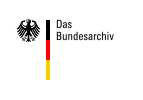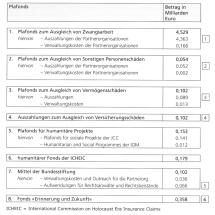
Portal on Forced Labour in the National Socialist State
zur Hauptnavigation zum Servicemenü direkt zum Inhalt
Payment Programme of the Foundation EVZ
The Federal Foundation "Remembrance, Responsibility and Future" (Stiftung EVZ) was endowed by the "Foundation Initiative of the German Economy" and the Federal Government. The law on the establishment of the foundation "Remembrance, Responsibility and Future" became effective on 12 August 2000 with the aim to provide individual humanitarian benefits to former NS forced labourers and a few other groups of victims of National Socialism channeled through international partner organisations. Total foundation funds amounted to 10.1 billion Deutschmarks. This amount is made up of voluntary payments of approximately 6,500 German enterprises (5.1 billion Deutschmarks) and the contribution of the Federal Government in the amount of 5 billion Deutschmarks.
Just under 8.7 billion Deutschmarks (4.45 billion Euro) were paid to former forced labourers in the form of individual one-time-payments until the foundation was closed.
To be eligible for payments as a former forced labourer, the person concerned was required to have been held prisoner in a concentration camp, ghetto or a similar place of detention associated with forced labour (so-called category A) or be abducted from his or her home country into the German Reich or in a territory occupied by German forces and was subjected to forced labour under conditions of detention, conditions similar to detention or any comparable extremely bad living conditions. (category B).
The amount of payments was a lump sum based on the two categories A and B and another category C, which allowed exceptional payments to victims with other characteristics of distress, mostly for forced labourers who had been involved in farm labour. According to this, those eligible for benefits of category A received up to 15,000 Deutschmarks (7,670 Euro) and those of the categories B and C up to 5,000 Deutschmarks (2,560 Euro).
The persons affected or their legal successors had to file their application until 31 December 2001 while they were allowed to produce evidence lateron. All application procedures had to be closed until 30 September 2006.
Payments were made to 1,665,000 victims and their legal successors to compensate for forced labour funded by the target ceiling. These payments covered the major part of the total amount available of 5.58 billion Euro with a total volume of 4.529 billion Euro.
Furthermore, payments were granted for:
- Bodily injuries due to medical experiments or placement in a home for the children of forced labourers ("nursing homes for foreign children"); in the latter case also those were eligible for benefits who had survived their placement in any such home or female forced labourers who had lost their child through violent seizure and placement in such home where the child died in the end. Payments from this target ceiling of up to 8,300 Deutschmarks (4,240 Euro) were made to more than 8,000 victims.
- Financial loss, when German enterprises had been the major and direct cause of the damage;
- Unpaid life insurance claims during the NS regime;
- Humanitarian fonds in favour of the survivors of the Holocaus and the Sinti and Roma persecuted in the same way. Three funds were established and allocated with the appropriate funding:
- A programme amounting to 276 million Deutschmarks reached the Conference on Jewish Material Claims Against Germany (JCC) for worldwide financing and funding of organisations and institutions, which maintain social services for Jewish National Socialist victims. More than 230 projects in 20 countries, primarily in the United States, Israel and the CIS states received funding.
- The International Organization for Migration (IOM) was assigned with the allocation of the 24 million Deutschmark fund in favour of the persecuted Sinti and Roma according to the Foundation Law, which turned out to be rather difficult. To begin with, the number of beneficiaries was totally vague. The organisation of the aid programme was also further complicated by the specific life situation of Roma communities in Eastern Europe, particularly the social discrimination and existing rivalry between communities. On top of that, there was the drawback of many Roma families who were very hard to reach as they were residing in remote places. Finally, they managed to identify 70,000 beneficiaries in 13 states of Central and Eastern Europe to be paid humanitarian financial aid. The payment programme of the IOM concentrated on providing quick and easy financial aid to the extremely needy Sinti and Roma who had well advanced in years.
- The third humanitarian fund went to the International Commission on Holocaust Era Insurance Claims (ICHEIC) and covered 350 million Euro funding several projects. The most extensive one was the Social Welfare Program, through which the home care of Jewish survivors of the National Socialist dictatorship, who were in need of care, was to be funded.

Ceilings for the tasks of the foundation
Source: "Gemeinsame Verantwortung und moralische Pflicht". Published by Michael Jansen and Günter Saathoff. Göttingen, 2007. P. 213
By the end of the year 2006 the financial compensation scheme of the foundation "Remembrance, Responsibility and Future" was closed. With some remaining funds some additional social and medical projects could be initiated in favour of former forced labourers in Eastern European states.
In line with the payments of the foundation "Remembrance, Responsibility and Future" the term "compensation" was always avoided; this was not due to claiming a certain legal status but rather due to the fact that in view of the horrendous violence and harm suffered the one-time payment, which was nevertheless rather low for the individual, was by no means intended to indicate a true "compensation". It was simply meant to represent a symbolic material gesture and the public recognition of the tragedy of those who had been victims of the National Socialism. Bearing this in mind, the compensation programme was officially closed in a ceremony by Federal President Horst Köhler at Bellevue Castle in the presence of German Chancellor Dr. Angela Merkel on 12th June 2007.
